A Comprehensive Guide to Slip and Fall Accidents in 2023
Slip and fall accidents are an all-too-common occurrence, but understanding them can help you to protect yourself and your loved ones. This comprehensive guide will provide you with a better understanding of slip and fall accidents, examining their causes, consequences, and legal implications. By the end of this article, you will have knowledge of what a slip and fall accident looks like and what you can do if it ever happens to you or someone you know.
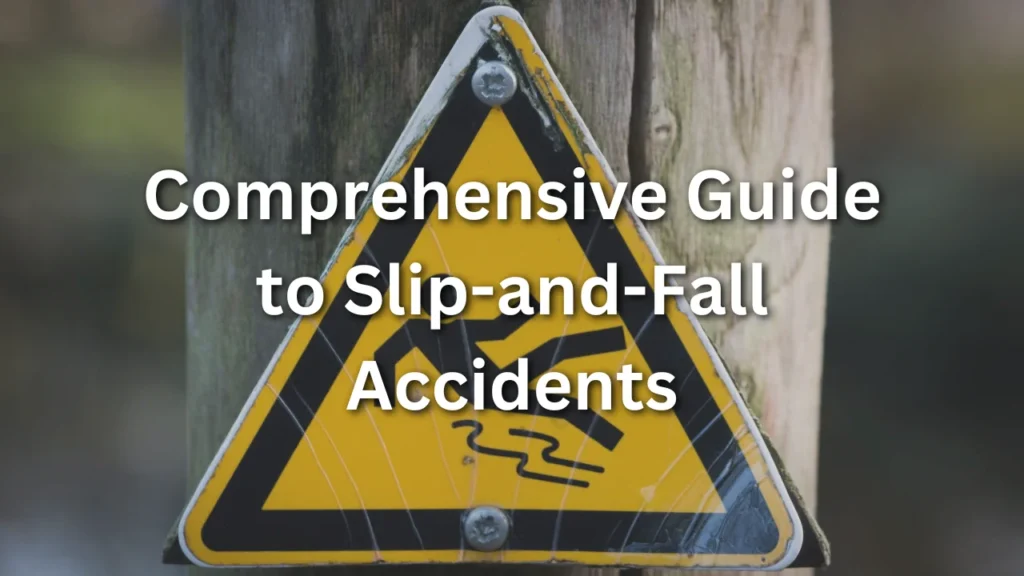
Were You Injured in a Slip-and-Fall Accident? Give Me a Call for a Free Consultation!
What is a Slip and Fall Accident?
A slip and fall accident is a type of personal injury incident that occurs when an individual gets injured while on another’s property. The liability for slip and fall accidents depends on the circumstances, such as the main cause of the accident, where the accident occurred, and the amount of effort put into following the location’s safety code.
Slip and fall accidents can take place in various locations, such as driveways, sidewalks, parks, schools, apartments, stores, workplaces, and more. Surprisingly, slip-and-fall accidents account for 12% of total falls, with consequences ranging from minor cuts and bruises to total physical incapacitation, and even death.
To recover compensation from a slip and fall accident, it is crucial to prove the property owner’s failure to take proper measures to keep their property safe. Property owners are responsible for keeping their premises free of slip and fall hazards. This is done through:
- Implementing non-slip rugs or mats
- Replacing torn carpeting
- Installing handrails
- Eliminating other hazards on the premises
Common Causes of Slip and Fall Accidents
Being aware of some of the common causes of slip and fall accidents can help you watch out for potentially dangerous situations. Here are some of the common causes of slip and fall accidents:
- Inadequate lighting
- Insufficient or improper signage
- Poorly maintained premises
- Tripping hazards
- Uneven surfaces
- Wet or slippery floors
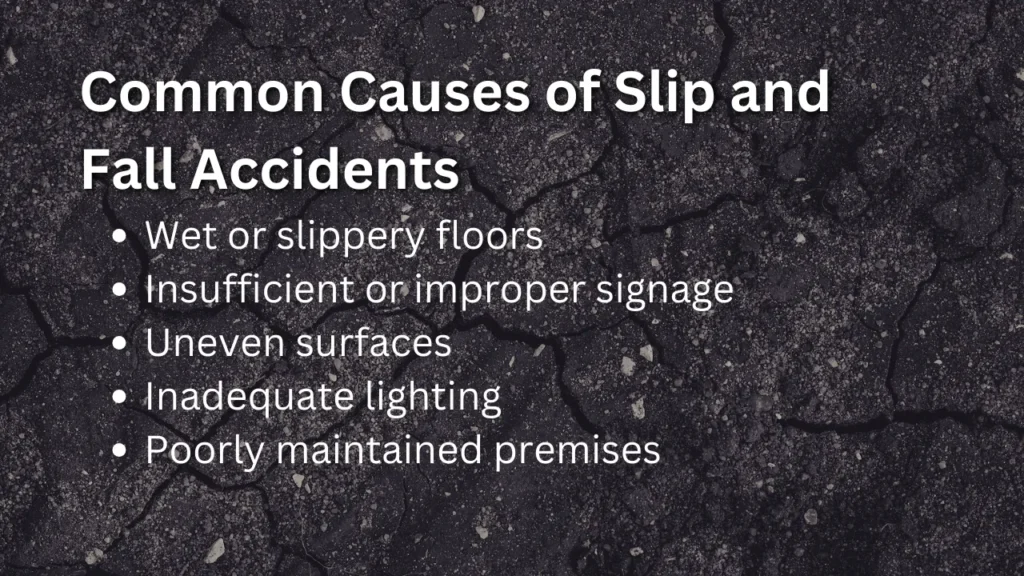
Wet Floors and Slippery Surfaces
Wet floors and slippery surfaces are some of the more common reasons why people slip and fall. Examples of such hazards include spills, ice, snow, rain, loose mats, rugs, and stepladders.
When these appear, property owners can take proper measures to ensure the safety of people. Some of these include cleaning up the wet floor, placing water-absorbing mats, placing non-slip materials, and putting up warning signs.
Placing a warning sign near the slippery surface is a must until the property owner can take care of the danger so people walking can easily become aware of the danger.
Poor Lighting
Poor lighting significantly contributes to slip and fall accidents by making potential hazards and obstacles harder to notice. It can also make it more difficult to tell any changes in elevation, such as steps or uneven surfaces, thus leading to trips and falls.
Furthermore, inadequate lighting can make it difficult to identify liquid spills or slippery surfaces, which increases the chance of an accident.
Here are some real-world scenarios where poor lighting can result in slip-and-fall accidents includes:
- Parking lots
- Apartment hallways
- Stairways
- Sidewalks
- Workplaces
There are lots of areas where slip and fall accidents can happen, and it is up to the property owners and employers to make sure that the environment is well-lit to make it a safe place to walk around.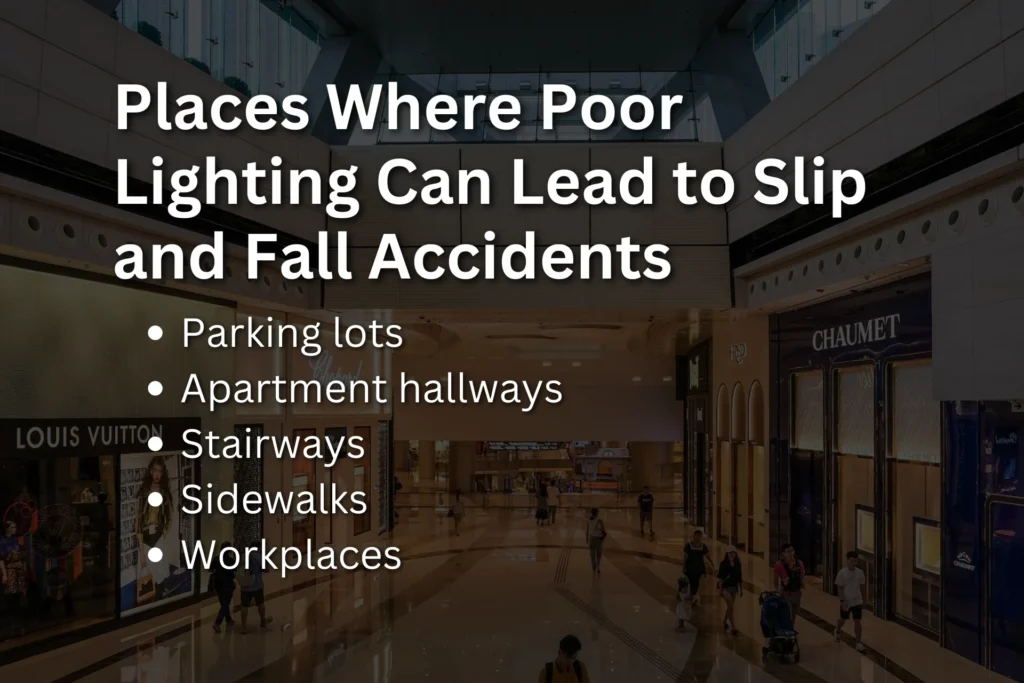
Uneven Surfaces and Torn Carpeting
Uneven surfaces and torn carpeting can present a tripping hazard. Torn carpeting, in particular, can increase the chances of slipping and losing balance. Slip and fall accidents due to uneven surfaces and torn carpeting are widely observed.
The US Bureau of Labor Statistics indicates that between 2021 and 2022, 22.6 percent of slip and fall incidents resulted in more than 14 days away from work. According to the Consumer Product Safety Commission, floors and flooring materials directly contribute to more than 2 million fall injuries each year.
Property owners can minimize the risk of slip and fall accidents by:
- Proactively maintaining the property
- Promptly addressing uneven surfaces
- Repairing torn carpeting
- Replacing damaged flooring materials immediately
- Timely repairs
These measures significantly help prevent accidents and guarantee the safety of visitors and occupants.
Injuries Resulting from Slip and Fall Accidents
Slip and fall accidents can result in a wide range of fall injuries, including:
- back pain
- bone fractures
- broken bones
- concussions
- dislocations
- fractures
- head injuries
- minor cuts and bruises
- spinal cord damage
- sprains
Serious injury cases, including traumatic brain injuries, can greatly impact the victim’s quality of life and ability to work, leading to financial strain from medical bills and emotional distress. According to the Centers for Disease Control and Prevention, about 13.5 out of 100,000 people die from unintentional falls.
This highlights the importance of taking precautions to avoid these fatal falls and seeking medical attention immediately after a fall occurs. Early treatment can significantly improve the prognosis and recovery time for many injuries.
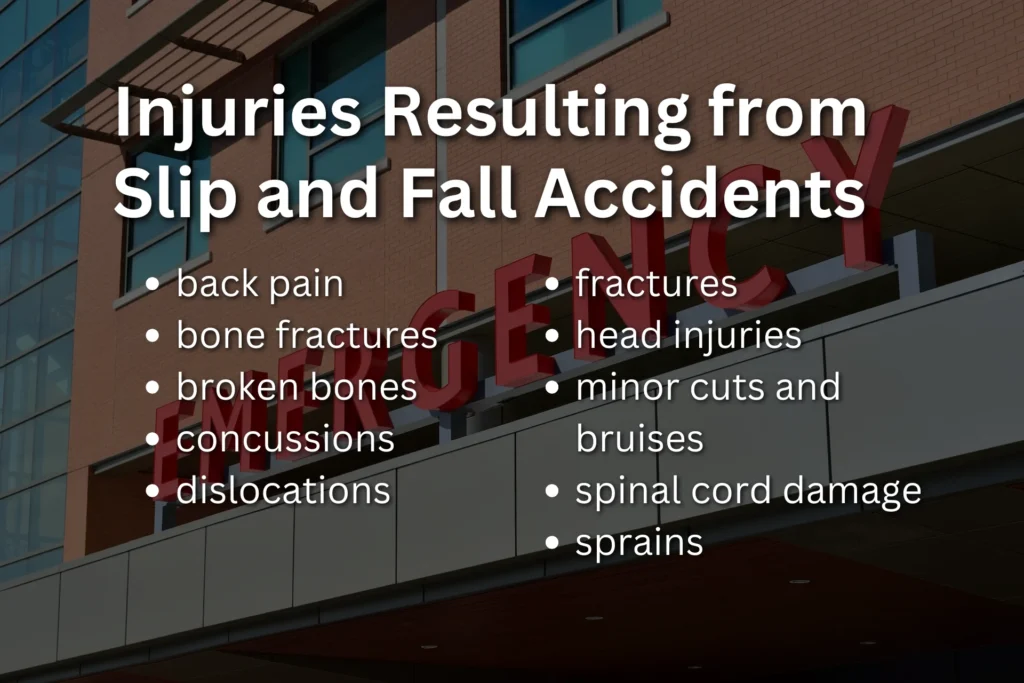 Establishing Liability in Slip and Fall Cases
Establishing Liability in Slip and Fall Cases
In slip and fall cases, establishing liability is crucial for obtaining compensation. To establish liability, one must demonstrate that the property owner was negligent and had knowledge of, or should have had knowledge of, the hazard that caused the fall on the property.
The following sections will go over the process of establishing negligence and pinpointing responsible parties in slip-and-fall cases.
Proving Negligence
In slip and fall cases, proving negligence is key as it forms the cornerstone of premises liability and compensation. To establish negligence, you must demonstrate that a hazardous condition presented an unreasonable risk to a person on the premises.
Additionally, you need to show that the property owner either created the hazardous condition, was aware of it and failed to address it, or that the condition had been present for a sufficient duration that the owner should have noticed and rectified before the slip and fall incident occurred.
Collecting evidence is vital for proving negligence. This may include:
- Expert testimony
- Photographs from the accident scene
- Medical records
- Witness statements
- Video surveillance footage
By presenting strong evidence and demonstrating negligence, your chances of obtaining a favorable outcome increase in the slip and fall case.
Identifying Responsible Parties
Identifying the responsible parties in slip and fall cases is a vital step in obtaining compensation. Liability for slip and fall accidents can be attributed to property owners, landlords, and businesses.
For example, homeowners and business owners/tenants of grocery stores, shopping malls, and other retail stores may be held accountable for slip-and-fall accidents on their properties.
In some cases, tenants may pursue a slip-and-fall case against their landlord if the landlord was aware of and had a responsibility to correct the hazardous condition but failed to do so in a negligent manner.
Collaborating with a seasoned attorney is beneficial in determining the right individual to file a legal action against following an injury from a slip and fall.
Gathering Evidence for Slip and Fall Claims
Gathering evidence is a crucial step in building a strong slip-and-fall claim. The more evidence you have to support your case, the greater your chances of obtaining a favorable outcome.
Key types of evidence in slip-and-fall cases include photographs of the accident scene, witness statements, and expert testimony. These types of evidence are essential in determining liability and proving negligence.
Prompt collection of evidence after the accident is crucial. Over time, physical evidence may be lost, and witness memories may fade.
Promptly collecting evidence, such as taking photographs of the accident site and obtaining contact information for witnesses, can significantly strengthen your slip and fall claim and improve your chances of obtaining compensation.
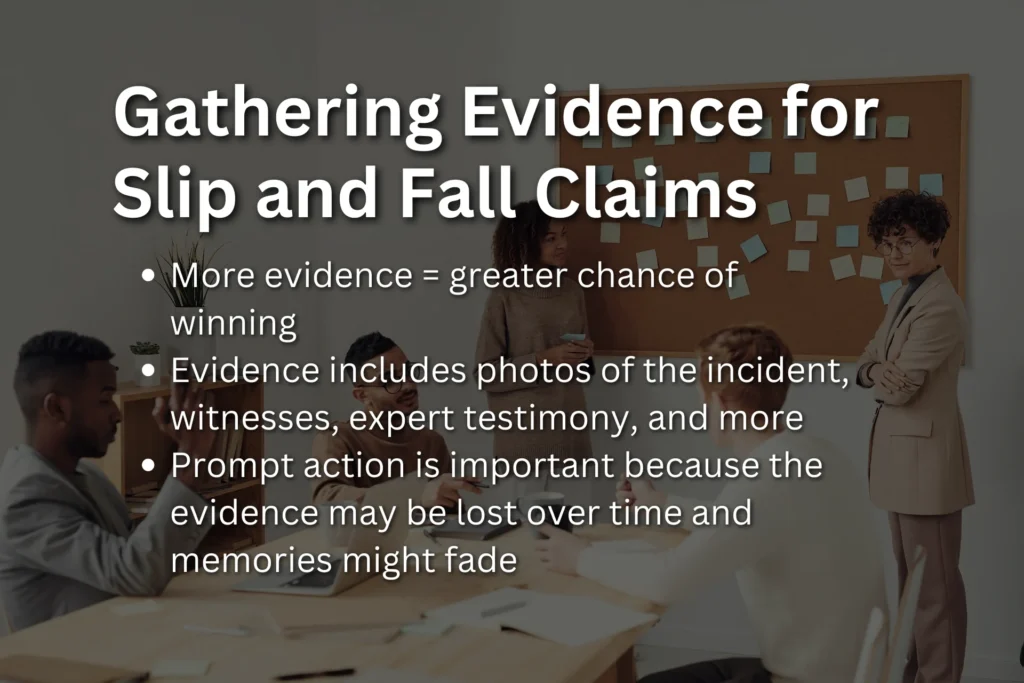 Compensation and Settlements in Slip and Fall Cases
Compensation and Settlements in Slip and Fall Cases
Compensation and settlements in slip and fall cases aim to provide financial relief for the losses suffered by the injured party. Factors that determine the value of a slip-and-fall case include quantifiable economic losses, the extent of the pain and suffering endured, and the attitude of the insurer involved. Settlements for slip and fall cases can vary widely, with many cases being resolved with a settlement of between $10,000 and $50,000.
Insurance and Slip and Fall Claims
Insurance plays a significant role in slip and fall claims, as insurance policies may be responsible for disbursing injury claims in such cases. Homeowners’ insurance is important – it should cover slip and fall claims that occur on the insured owner’s property.
Such protection can provide peace of mind in the event of an incident. In cases where a slip and fall accident occurs at work, the injured party would need to file a workers’ compensation claim instead of a slip and fall lawsuit.
Understanding the limitations of insurance coverage in slip and fall cases is crucial. The homeowner’s insurer is only obligated to pay up $50,000 in liability coverage. This is the maximum amount they are liable for. If the injured party’s losses exceed this amount, they may consider pursuing a claim against the homeowner directly.
Working with an experienced attorney, such as a fall lawyer, can help navigate the complexities of insurance coverage and maximize the potential for a favorable outcome in your slip and fall claim.
Legal Assistance for Slip and Fall Cases
Obtaining legal assistance for slip and fall cases is key to securing a fair resolution and appropriate compensation. An experienced attorney can help guide you through the legal process, gather evidence, establish negligence, and identify responsible parties.
They possess the necessary resources and expertise to ensure a successful outcome and provide comprehensive assistance throughout the process.
If you or a loved one suffered injuries from a slip and fall accident, an immediate consultation with a seasoned attorney is advisable. They can help you understand your legal options, determine the best course of action, and work tirelessly to secure the compensation you deserve. Don’t hesitate to reach out to a qualified legal professional for a free consultation and case evaluation.
Summary
In conclusion, understanding slip and fall accidents and their legal implications is essential for protecting yourself and your loved ones. By being aware of the common causes, the injuries that can result, and the process of establishing liability, you’ll be better equipped to navigate the complex world of slip-and-fall accidents and claims.
Remember to seek legal assistance from an experienced attorney to ensure the best possible outcome for your case. Stay vigilant, stay informed, and stay safe.
Frequently Asked Questions
Why are slip-and-fall cases hard to win?
Slip and fall cases are notoriously difficult to win due to the difficulty in proving that someone’s negligence led to your injuries, as it is often an unfortunate event beyond anyone’s control.
What is the highest settlement for a slip and fall?
The highest settlement for a slip and fall ever awarded was over 20 million dollars, given to an elderly woman who suffered severe injuries after slipping on a wet tile floor in a hotel lobby.
What to do when you slip and fall?
Report your accident to the property owners or managers, seek medical help, and document everything. Take detailed notes and save everything related to the accident, and avoid discussing them on social media.
What does it mean when you slip and fall?
A slip and fall accident is an incident where someone loses traction or stumbles, resulting in a fall due to an object or circumstance, such as a slippery floor or badly lit stairwell.
How much money can you get for a slip and fall?
Slip and fall case settlements can range from $10,000 to $50,000, depending on the severity of the injury and related losses.







